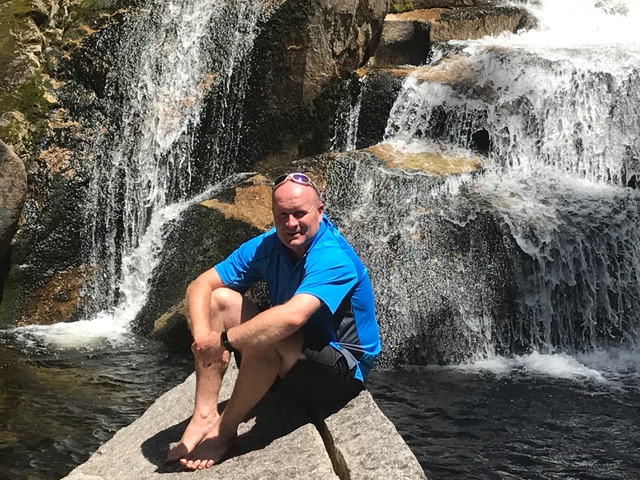Steve Allan, from New Zealand, was diagnosed with Polycystic Kidney Disease (a genetic disorder which causes cysts filled with fluid to form in the kidneys) following the loss of his mother due to a brain aneurysm when he was a teenager. Steve opens up about the progression of the disease, his fears regarding undergoing dialysis, and his everyday struggles.
When I was 18, my mother suffered an initially unknown medical event. It was soon after discovered that an aneurysm in her brain had ruptured. She was taken in for emergency surgery when she suffered a second bleed. She never regained consciousness and as a family we ended up turning off her life support.
We were then advised that brain aneurysms are connected to Polycystic Kidney Disease, which is hereditary, and advised to get tested. Thankfully our brother was clear of the disease, however my sister and I were both confirmed as having it. My GP explained that every generation the disease gets worse and, as my mum died at 46 years old, I should not expect to get to that age. I gave up on the idea of ever getting married, as I was not prepared to bring children into this world for them to experience a death sentence of their father.
Fast forward to 2015, having had a routine MRI scan, it was discovered that I also had a brain aneurysm. With the kidney function starting to fall, many conversations were had. I learnt that I would never get a kidney transplant with an active brain aneurysm. With my sister already well into her eleventh year of dialysis, I knew dialysis was not what I wanted for the rest of my days. The only option was surgery.
In 2020 we went down this track. What started off as surgery via the groin to ‘fix’ the aneurysm, it changed course two weeks out from surgery and became open head surgery. The night before surgery I was told about a second aneurysm. The medical teams were 50/50 about whether they would operate as the risks of surgery outweighed the risk of both aneurysms.
Having journeyed with this with my mother, I knew the risks. Honestly, I would rather have died on the table than face the rest of my life on dialysis. So the surgery went ahead. The 6 months recovery turned into 3 months. A truly remarkable recovery, especially considering that one of the aneurysms ruptured on the table.
| All the way up to surgery, I was told by the renal team that I did not know how sick I was, and that by going onto dialysis I would suddenly realize what I had been fighting. | I would have so much more energy to start with, let alone the added benefit to my body by removing creatinine. |
2021 started off with being admitted to hospital with low sodium levels as apparently I was drinking too much water and flushing the sodium out. I was running the risk of seizures, yet I felt completely healthy. Kidney function was around 15%. I then had my first round of gout, which put me on crutches. Having recovered from that I went back to my full-on lifestyle. Working, along with competitive horse riding, and coaching other horse riders.
That year in February, I took a nasty fall off a young horse and basically urinated blood for 4 weeks. We had many tests over this time to work out what damage I had done. My kidney function took a hit to, function decreased to 9%. Other than the kidney function being low, I still felt unstoppable. My specialist booked me in for a peritoneal dialysis (PD) catheter insert. With having blood tests weekly, the kidney function popped back up to 8% and held there. Much to my delight, the specialist deferred surgery as I was deemed stable, and I was not symptomatic.
By August, with my specialist away, the weekly blood test showed me back at 7%, and the medical team rebooked surgery. Gutted was an understatement. However, this time there was no reprieve. So the tube went in. I went from a fully functional person to an invalid overnight.
All the way up to surgery, I was told by the renal team that I did not know how sick I was, and that by going onto dialysis I would suddenly realize what I had been fighting. I would have so much more energy to start with, let alone the added benefit to my body by removing creatinine.
Having been told initially after surgery that I could not lift for 6 weeks, at the end of the 6 weeks I was told that while being on PD I would not be able to lift anything over 8kg while I had 2L of fluid on board. Which was 24/7. This was gutting.
I started manual bags in October. Talk about a massive adjustment to my lifestyle. My super busy life meant trying to work out being home every three hours to exchange fluids. Frustrating, but I had to do what had to be done. As I could not access a second fluid heater, I created one out of an electric pet blanket and an insulated box, meaning that I took my solutions warmer to work and left the pet blanket/box at home so that I had warm fluids with me wherever I was, saving me from constantly packing up and unpacking every day.
In December we did the PET test and I qualified for a cycler [Editor’s note: A cycler is a machine used in automated peritoneal dialysis. The machine can be programmed to give different amounts of dialysis solutions at different times].
The renal team told me with excitement that this would free up my days. The best gift they could think of with Christmas looming. So this step happened. The cycler did not take off fluid like the manual bags did, and so I ended up with a fluid restriction of 1L. This is less than half of what I had been drinking. There were nights where the machine out fluid into me, rather than taking it off. Thus I added a manual bag or two by day.
Nevertheless, I still had too much fluid on board. I kept the 9-hour cycler treatment at night, along with some manual exchanges by day. My energy level dropped lower and lower. I no longer trusted myself to stand up, and I no longer felt safe to drive. For three weeks over Christmas/New Year, if I managed to get beyond my bed or lounge it was a good day. The quick supermarket shop meant a 2-hours sleep to recover afterwards. The renal nurse kept saying that the numbers were fine.
So I settled into what appeared to be the new me. It dawned on me that the whole renal team were right, I did not know how sick I was before dialysis. I sure did know how sick I was now. Do I resign from my job, sell all the horses, and just exist?
During a specialist appointment, the doctor declared that I was ‘dry’ and increased my fluid restriction to 2L. Most of my symptoms were from being dehydrated. I stopped doing day manual exchanges. The doctor also believed that we could improve my life from where I was at.
This gave me hope that I may be able to get off the couch again. While I still doubt that I will ever have the energy that I had prior to dialysis, I do have a wonderfully generous friend who is working through the living kidney donation process. It is the most humbling journey, to think that someone would willingly carve out a body organ for me. If this goes ahead, I am feeling hopeful that one day I may ride a horse again.
I am incredibly encouraged to hear of other people’s positive experiences with dialysis. Maybe in time the terrible start to this experience may turn around? Only time will tell.
Disclaimer: The blog series is intended for informational purposes only and is not meant to endorse or promote any specific drug, product, or brand. Each individual’s experience is unique and should not be construed as medical advice or a guarantee of similar results for others. Always consult a qualified healthcare professional before making any decisions regarding your health and well-being.


